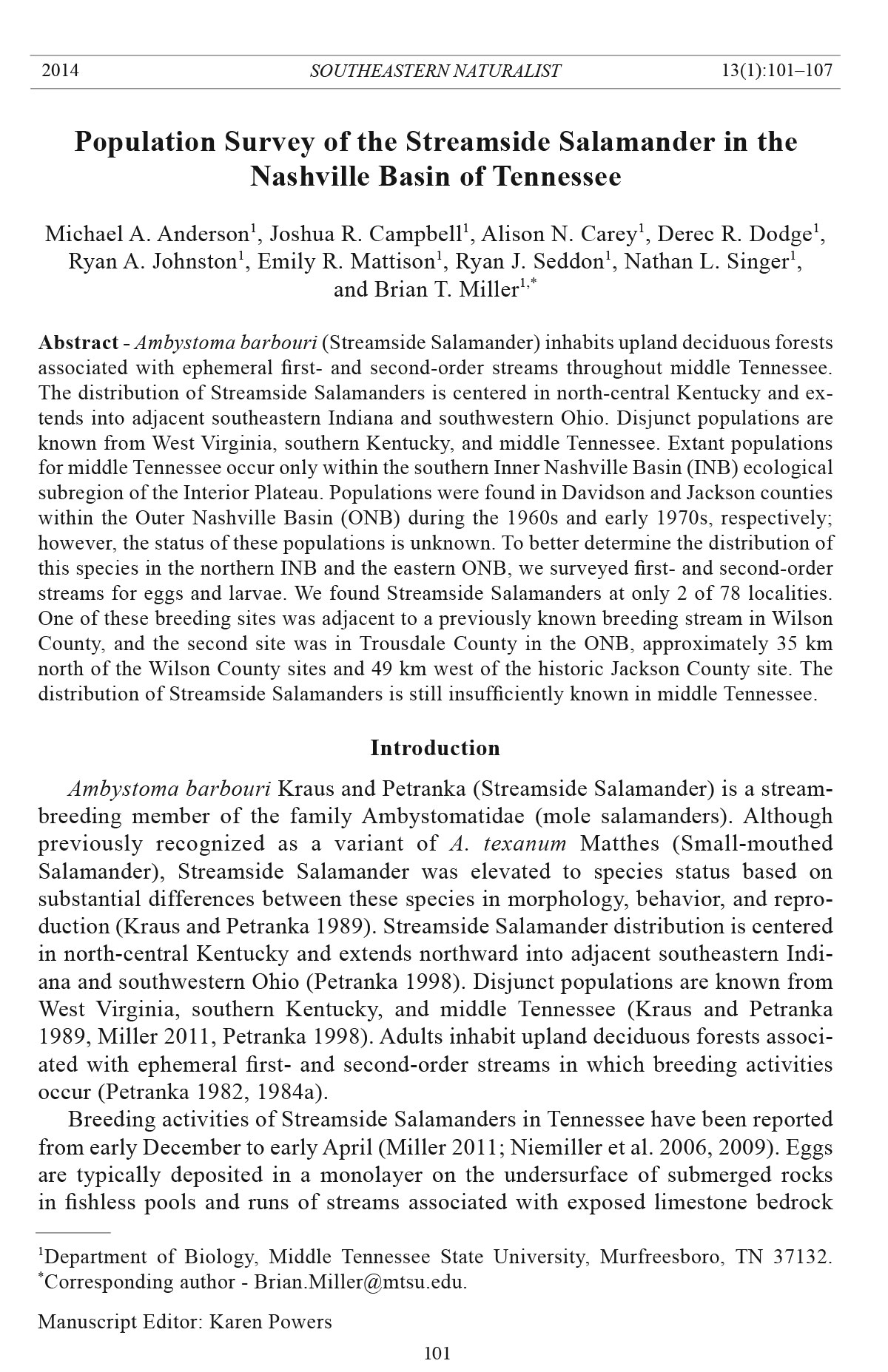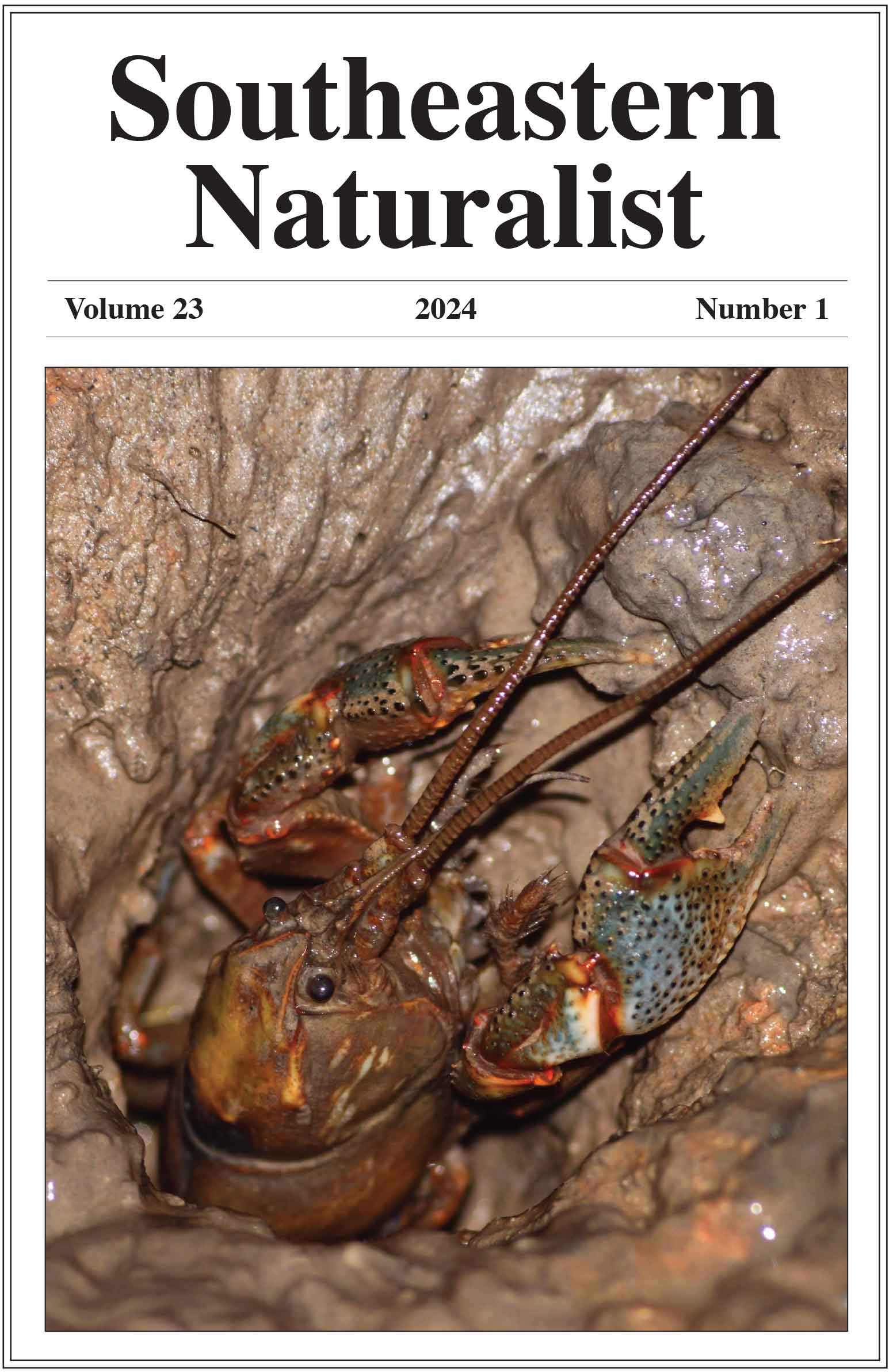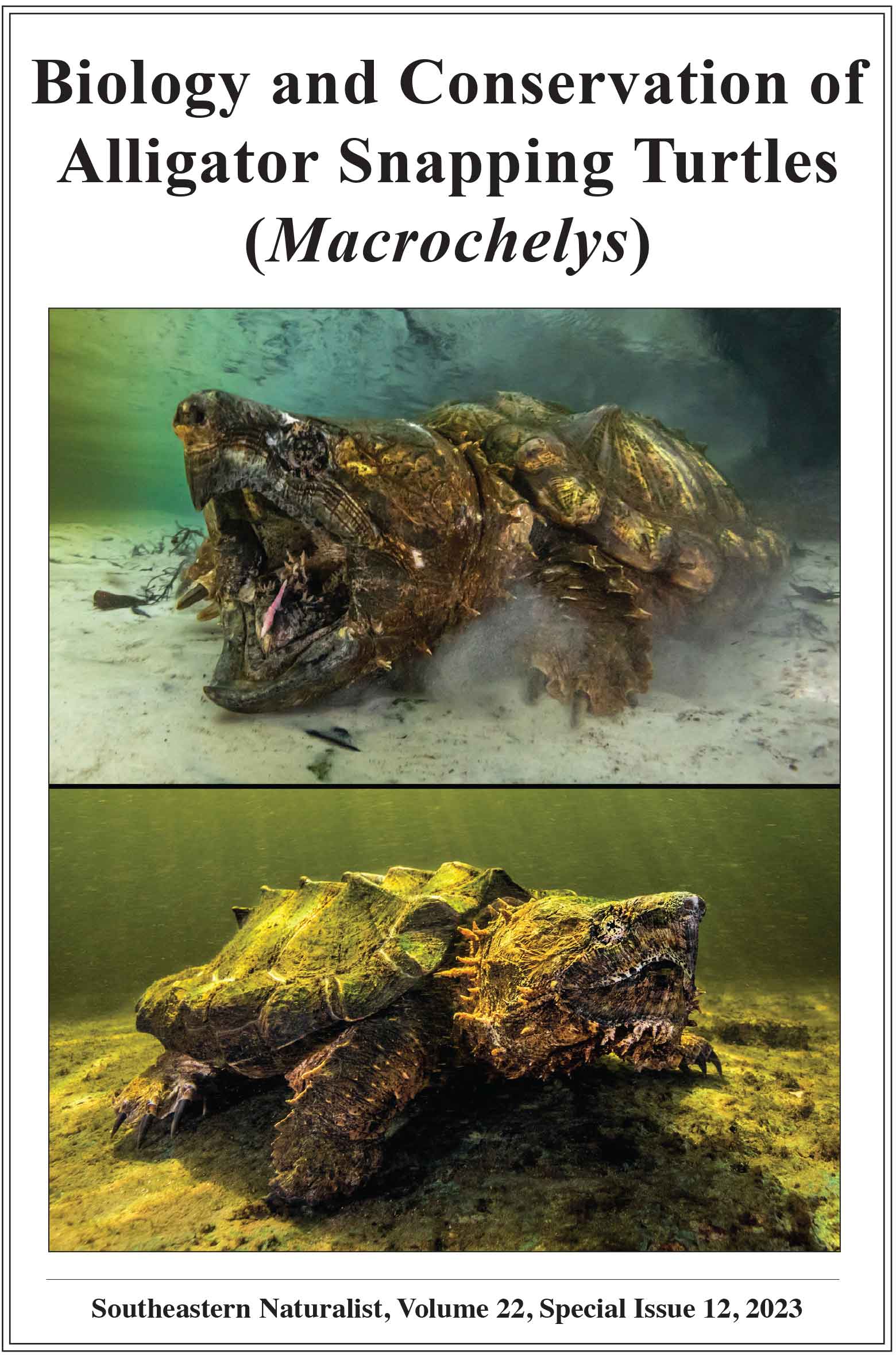Population Survey of the Streamside Salamander in the
Nashville Basin of Tennessee
Michael A. Anderson, Joshua R. Campbell, Alison N. Carey, Derec R. Dodge, Ryan A. Johnston, Emily R. Mattison, Ryan J. Seddon, Nathan L. Singer, and Brian T. Miller
Southeastern Naturalist, Volume 13, Issue 1 (2014): 101–107
Full-text pdf (Accessible only to subscribers.To subscribe click here.)

Southeastern Naturalist
101
M.A. Anderson, et al.
22001144 SOUTHEASTERN NATURALIST 1V3o(1l.) :1130,1 N–1o0. 71
Population Survey of the Streamside Salamander in the
Nashville Basin of Tennessee
Michael A. Anderson1, Joshua R. Campbell1, Alison N. Carey1, Derec R. Dodge1,
Ryan A. Johnston1, Emily R. Mattison1, Ryan J. Seddon1, Nathan L. Singer1,
and Brian T. Miller1,*
Abstract - Ambystoma barbouri (Streamside Salamander) inhabits upland deciduous forests
associated with ephemeral first- and second-order streams throughout middle Tennessee.
The distribution of Streamside Salamanders is centered in north-central Kentucky and extends
into adjacent southeastern Indiana and southwestern Ohio. Disjunct populations are
known from West Virginia, southern Kentucky, and middle Tennessee. Extant populations
for middle Tennessee occur only within the southern Inner Nashville Basin (INB) ecological
subregion of the Interior Plateau. Populations were found in Davidson and Jackson counties
within the Outer Nashville Basin (ONB) during the 1960s and early 1970s, respectively;
however, the status of these populations is unknown. To better determine the distribution of
this species in the northern INB and the eastern ONB, we surveyed first- and second-order
streams for eggs and larvae. We found Streamside Salamanders at only 2 of 78 localities.
One of these breeding sites was adjacent to a previously known breeding stream in Wilson
County, and the second site was in Trousdale County in the ONB, approximately 35 km
north of the Wilson County sites and 49 km west of the historic Jackson County site. The
distribution of Streamside Salamanders is still insufficiently k nown in middle Tennessee.
Introduction
Ambystoma barbouri Kraus and Petranka (Streamside Salamander) is a streambreeding
member of the family Ambystomatidae (mole salamanders). Although
previously recognized as a variant of A. texanum Matthes (Small-mouthed
Salamander), Streamside Salamander was elevated to species status based on
substantial differences between these species in morphology, behavior, and reproduction
(Kraus and Petranka 1989). Streamside Salamander distribution is centered
in north-central Kentucky and extends northward into adjacent southeastern Indiana
and southwestern Ohio (Petranka 1998). Disjunct populations are known from
West Virginia, southern Kentucky, and middle Tennessee (Kraus and Petranka
1989, Miller 2011, Petranka 1998). Adults inhabit upland deciduous forests associated
with ephemeral first- and second-order streams in which breeding activities
occur (Petranka 1982, 1984a).
Breeding activities of Streamside Salamanders in Tennessee have been reported
from early December to early April (Miller 2011; Niemiller et al. 2006, 2009). Eggs
are typically deposited in a monolayer on the undersurface of submerged rocks
in fishless pools and runs of streams associated with exposed limestone bedrock
1Department of Biology, Middle Tennessee State University, Murfreesboro, TN 37132.
*Corresponding author - Brian.Miller@mtsu.edu.
Manuscript Editor: Karen Powers
Southeastern Naturalist
M.A. Anderson, et al.
2014 Vol. 13, No. 1
102
(Holomuzki 1991, Kats and Sih 1992, Niemiller et al. 2006, Regester and Miller
2000). However, eggs have been found attached to submerged vegetation (Niemiller
et al. 2009), as well as wholly or partially submerged foreign objects such as
street signs (M.A. Anderson and B.T. Miller, pers. observ.). Oviposition in low-order
streams associated with cedar glade habitats, including terrestrial breeding, has
recently been reported (Mattison and Miller 2011, Niemiller et al. 2011). Although
pond-breeding and stream-breeding Streamside Salamander populations have been
reported (Petranka 1984b, Venesky and Parris 2009), only stream-breeding variants
are known from Tennessee (Niemiller et al. 2009).
Extant Tennessee populations occur in Bedford, Marshall, and Rutherford
counties (Niemiller et al. 2006, 2011; Regester and Miller 2000). Historically,
breeding populations were found in Davidson County (Ashton 1966, Scott et al.
1997), and juveniles have been reported from Jackson County (Scott et al. 1997).
However, the status of these populations is unknown, with the former presumed
extirpated as a result of urbanization of metropolitan Nashville (Niemiller et al.
2006). Furthermore, recently discovered populations have been associated only
with the Inner Nashville Basin (INB); whereas, the aforementioned historic sites
are located in the Outer Nashville Basin (ONB). Although the reported absence
of Streamside Salamanders at two historic sites in Rutherford County (Niemiller
et al. 2006)—a region that is experiencing tremendous human population growth
(Mackun and Wilson 2011)—may indicate a potential decline in the middle Tennessee
populations, the relatively recent discovery of eggs and larvae in a first-order
stream in the Cedars of Lebanon State Forest (CLSF) in Wilson County (INB;
Niemiller et al. 2011) indicates that our understanding of this species’ distribution
in Tennessee is still poor.
The Tennessee Wildlife Resources Agency currently classifies the Streamside
Salamander as deemed in need of management, a rank analogous to the special
concern category used in other conservation classification schemes (Withers
2009). The International Union for Conservation of Nature (IUCN) lists Streamside
Salamander as near threatened because the species has a limited range, and
declining habitat extent and quality (Hammerson 2004). Because Streamside
Salamanders are associated with ephemeral streams in deciduous habitats, nearstream
development and deforestation may have severe detrimental effects on
the survivorship of this species throughout its range (Petranka 1998, Watson and
Pauley 2005). To ascertain the status of historic populations and to determine the
connectivity of ONB and INB populations, we surveyed for breeding activity in
first- and second-order streams in the eastern section of the northern ONB and
northern INB of middle Tennessee.
Methods
We searched for eggs, larvae, and adult Streamside Salamanders in 78 first- and
second-order streams at road crossings in Davidson, DeKalb, Jackson, Smith, Sumner,
Trousdale, and Wilson counties from January to April 2011 (Fig. 1). All streams
surveyed were located within the northern INB and western and eastern ONB
Southeastern Naturalist
103
M.A. Anderson, et al.
2014 Vol. 13, No. 1
ecological subregions of the Interior Plateau in the Cumberland, Caney Fork and
Stones River watersheds (Griffith et al. 1997). We chose these sites based on similarity
of habitat and proximity to historic and current breeding localities. Streams
were low gradient and characterized by large expanses of exposed bedrock. Many
of the streams surveyed were ephemeral, and all lacked predatory fish populations.
We deemed streams with predatory fish (larvae, fry, or adults) as unlikely breeding
localities and did not sample them.
Our sampling methods closely followed Niemiller et al. (2006). Because we
were not extrapolating density data, simple presence/absence data were sufficient.
We sampled survey sites ≈100 m upstream and downstream from road crossings.
Although streams may intersect roads at multiple points, we considered each road
crossing as a distinct locality. We sought to maximize our search area and number
of sites sampled, and therefore, visited each site only once. We lifted all rocks and
other cover objects within streams to search for eggs and along stream banks to
locate adults. We returned all cover objects to their original position to minimize
habitat disturbance. We visually inspected pool and riffle habitat for larvae.
Figure 1. First- and second-order streams surveyed for Ambystoma barbouri (Streamside
Salamander) between January and April 2011. All search efforts were within the northern
Outer Nashville Basin and northern Inner Nashville Basin, including portions of Davidson,
DeKalb, Jackson, Smith, Sumner, Trousdale, and Wilson counties. Historic sites and currently
known breeding sites are also noted. Sites indicated by a solid square are newly found
breeding localities.
Southeastern Naturalist
M.A. Anderson, et al.
2014 Vol. 13, No. 1
104
Results
We observed Streamside Salamanders at 2.6% (2 of 78) of streams sampled
(Fig. 1). We found several clutches of eggs and many larvae in a first-orde r stream
≈3 km from the known Wilson County breeding locality in the CLSF, and we observed
one clutch of eggs comprising three live and many dead embryos in various
stages of development in a first-order stream in Trousdale County (TC). These findings
documented new breeding localities for Streamside Salamander, and the TC
site is the northern-most known extant breeding locality in Tennessee.
Discussion
Streamside Salamander populations in Tennessee are known only from the Inner
Nashville Basin and Outer Nashville Basin ecoregions. The INB comprises
most of Rutherford and Wilson counties, northern Bedford County, and extreme
eastern Maury County. The Nashville Basin (Inner and Outer) is characterized by
relatively flat terrain with many low- to moderate-gradient streams. At least 1322
named streams, and countless unnamed tributaries, occur within the INB and ONB
(USGS 1981). We do not know how many of these streams are ephemeral, but of the
60 named streams in Rutherford County, only 15 are free-flowing throughout the
year. If a similar proportion exist in other counties in the Nashville Basin, then there
are likely >990 ephemeral streams in the Nashville Basin that provide potential
breeding habitat for Streamside Salamanders. To date, breeding of this species has
been documented in fewer than 25 (0.03%) streams in the Nashville Basin (Ashton
1966, Niemiller et al. 2006, Scott et al. 1997). However, Streamside Salamanders
have not been found in more southern and western regions of the Nashville Basin
(e.g., streams in Maury, Moore, Lincoln, and Giles counties). These four counties
account for 433, nearly 33%, of named streams in the Nashville Basin. If we assume
that breeding Streamside Salamanders are absent from these streams, and we
eliminate them from the list of potential breeding localities, Streamside Salamanders
have been found in 0.04% of presumed suitable streams in the Nashville Basin.
Regardless of potential streams, Niemiller et al. (2006) found this species breeding
in 12.5% of the streams they sampled in Rutherford, Bedford, and Marshall
counties, and we found the species breeding in 2.6% of streams we sampled. Most
known populations are clustered in the center of the Nashville Basin in southern
Rutherford and northern Bedford counties, so our data represent survey efforts in
distant localities, generally in locations nearing the northern and eastern boundaries
of the Highland Rim, the upland area surrounding the Nashville Basin. Although
our survey efforts were thorough, small populations might have gone undetected.
Niemiller et al. (2006) reported an absence of individuals in sites where Streamside
Salamander presence has since been confirmed (current study, Estabrooks 2010,
Miller 2011).
The lack of breeding populations observed at the sites we sampled may be a consequence
of continuous habitat alteration and dissection by roadways. Whereas the
new Wilson County locality represents a new breeding site, the Trousdale County
Southeastern Naturalist
105
M.A. Anderson, et al.
2014 Vol. 13, No. 1
population represents a new county record for Streamside Salamander, as well as
the only known breeding population in the Outer Nashville Basin. We did not find
evidence of breeding near the historic sites in Jackson and Dav idson counties.
Although we discovered eggs in a first-order stream in Trousdale County (TC),
most of the embryos were dead in the only clutch found. The lack of viable embryos
within the solitary clutch, as well as the lack of additional clutches in what appears
to be suitable habitat is perplexing. Apart from a small riparian forest buffer, this
breeding location is surrounded by land used for agriculture on the north and west
sides. Similar habitat supports relatively large populations of Streamside Salamander
(based on egg densities) in southern Rutherford and northern Bedford counties
(Estabrooks 2010). However, all of TC is contained within the Old Hickory Lake
watershed, in which 50% of the landscape is mixed or deciduous forest, with agricultural
activities, such as row crops and pastures, accounting for less than 40% of land
use (Goodhue et al. 2007). Data concerning stressor-pathogen effects on amphibians—
pesticides, UV-B radiation, temperature, parasites, bacteria, viruses—are
conflicting, and seem to be context-dependent (Forson and Storfer 2006, Mann et
al. 2009). The apparent lack of additional fertilized egg masses at the TC site may
be a temporal artifact, resulting from the date of our survey, which occurred late in
the breeding season. Likewise, the lack of Streamside Salamander larvae does not
necessarily indicate their absence; the stream was fast-flowing, which may have
precluded larvae from persisting near the site of egg deposition.
Although we found Streamside Salamanders in only 2 of 78 streams surveyed,
our documentation of the TC breeding site extended the known breeding range in
Tennessee by 35 km, and added a site adjacent to a recently discovered locality
(Wilson County site; Niemiller et al. 2011). In addition, the TC site represents the
only known Streamside Salamander population in the Outer Nashville Basin. Our
results increase the number of documented current breeding localities from 16 to
18. We contend that although past and present survey efforts to determine this species
distribution have been extensive, there is still a dearth in distributional data for
Tennessee populations of Streamside Salamander.
Literature Cited
Ashton, T.E. 1966. An annotated check-list of order Caudata (Amphibia) of Davidson
County, Tennessee. Journal of the Tennessee Academy of Science 46:106–111.
Estabrooks, D. 2010. Range, density, and habitat preference of Tennessee populations of the
Streamside Salamander (Ambystoma barbouri). M.Sc. Thesis. Middle Tennessee State
University, Murfreesboro, TN. 105 pp.
Forson, D., and A. Storfer. 2006. Effects of atrazine and iridovirus infection on survival and
life-history traits of the Long-toed Salamander (Ambystoma macrodactylum). Environmental
Toxicology and Chemistry 25:168–173.
Goodhue, A., J. Smith, J. Holland, R. Cochran, D. Duhl, R. McGahen, J. Upham, J. Watson,
and S. Wang. 2007. Old Hickory Lake Watershed (05130201) of the Cumberland River
Basin Water Quality Management Plan. Watershed Management Section, Division of
Pollution Control, Tennessee Department of Environment and Conservation, Nashville,
TN. Available online at http://www.tn.gov/environment/watersheds/four/oldhickory/.
Accessed 13 August 2013.
Southeastern Naturalist
M.A. Anderson, et al.
2014 Vol. 13, No. 1
106
Griffith, G.E., J.M. Omernik, and S. Avedo. 1997. Ecoregions of Tennessee. Available online
at http://www.epa.gov/wed/pages/ecoregions/tn_eco.htm. Accessed 13 August 2013.
Hammerson, G. 2004. Ambystoma barbouri. IUCN 2011. IUCN Red List of threatened
species. Available online at http://www.iucnredlist.org/details/59053/0. Accessed 13
August 2013.
Holomuzki, J.R. 1991. Macrohabitat effects on egg deposition and larval growth, survival,
and instream dispersal in Ambystoma barbouri. Copeia 1991:687–694.
Kats, L.B., and A. Sih. 1992. Oviposition site selection and avoidance of fish by Streamside
Salamanders (Ambystoma barbouri). Copeia 1992:468–473.
Kraus, F., and J.W. Petranka. 1989. A new sibling species of Ambystoma from the Ohio
River drainage. Copeia 1989:94–110.
Mackun, P., and S. Wilson. 2011. Census 2010 brief: Population change and distribution
2000 to 2010. US Census Bureau, Washington, DC 12 pp.
Mann, R.M., R.V. Hyne, C.B. Choung, and S.P. Wilson. 2009. Amphibians and agricultural
chemicals: Review of the risks in a complex environment. Environmental Pollution
157:2903–2927.
Mattison, E., and B.T. Miller. 2011. Ambystoma barbouri (Streamside Salamander). Terrestrial
breeding sites. Herpetological Review 42:578–579.
Miller, B.T. 2011. Streamside Salamander, Ambystoma barbouri. Pp. 73–76, In M.L. Niemiller
and R.G. Reynolds (Eds.). The Amphibians of Tennessee. University of Tennessee
Press, Knoxville, TN. 369 pp.
Niemiller, M.L., B.M. Glorioso, C. Nicholas, J. Phillips, J. Rader, E. Reed, K.L. Sykes, J.
Todd, G.R. Wyckoff, E.L. Young, and B.T. Miller. 2006. Status and distribution of the
Streamside Salamander, Ambystoma barbouri, in middle Tennessee. American Midland
Naturalist 156:394–399.
Niemiller, M.L., B.M. Glorioso, C. Nicholas, J. Phillips, J. Rader, E. Reed, K.L. Sykes, J.
Todd, G.R. Wyckoff, E.L. Young, and B.T. Miller. 2009. Notes on the reproduction of
the Streamside Salamander, Ambystoma barbouri, from Rutherford County, Tennessee.
Southeastern Naturalist 8:37–44.
Niemiller, M.L., R.G. Reynolds, B.M. Glorioso, J. Spiess, and B.T. Miller. 2011. Herpetofauna
of the cedar glades and associated habitats of the Inner Central Basin of middle
Tennessee. Herpetological Conservation and Biology 6:135–149.
Petranka, J.W. 1982. Geographic variation in the mode of reproduction and larval characteristics
of the Small-mouthed Salamander (Ambystoma texanum) in the east-central
United States. Herpetologica 38:333–336.
Petranka, J.W. 1984a. Incubation, larval growth, and embryonic and larval survivorship
of Smallmouth Salamanders (Ambystoma texanum) in streams. Copeia 1984:862–868.
Petranka, J.W. 1984b. Sources of interpopulational variation in growth responses of larval
salamanders. Ecology 65:1857–1865.
Petranka, J.W. 1998. Salamanders of the United States and Canada. Smithsonian Institution
Press, Washington, DC. 587 pp.
Regester, K.J., and B.T. Miller. 2000. Ambystoma barbouri (Streamside Salamander). Reproduction.
Herpetological Review 31:232.
Scott, A.F., B.T. Miller, M. Brown, and J.W. Petranka. 1997. Geographic distribution: Ambystoma
barbouri. Herpetological Review 28:155.
US Geological Survey (USGS). 1981. Geographic names phase I data compilation. Geographic
Names Information Service (GNIS). Available online at http://geonames.usgs.
gov/domestic/. Accessed 13 August 2013.
Southeastern Naturalist
107
M.A. Anderson, et al.
2014 Vol. 13, No. 1
Venesky, M.D., and M.J. Parris. 2009. Intraspecific variation in life-history traits among
two forms of Ambystoma barbouri larvae. American Midland Naturalist 162:195–199.
Watson, M.B., and T.K. Pauley. 2005. Ambystoma barbouri. Pp. 603–605, In J.J. Lannoo
(Ed.). Amphibian Declines: The conservation Status of United States Species. University
of California Press, Berkeley, CA. 1094 pp.
Withers, D.I. 2009. A guide to the rare animals of Tennessee. Division of Natural Areas,
Tennessee Department of Environment and Conservation, Nashville, TN. 72 pp.













 The Southeastern Naturalist is a peer-reviewed journal that covers all aspects of natural history within the southeastern United States. We welcome research articles, summary review papers, and observational notes.
The Southeastern Naturalist is a peer-reviewed journal that covers all aspects of natural history within the southeastern United States. We welcome research articles, summary review papers, and observational notes.